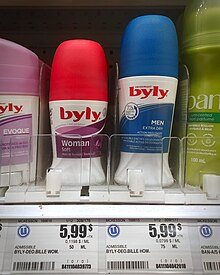Higher pricing of products marketed to women
 Gender-based price difference between Byly deodorants for women (50 mL) vs men (75 mL). Both are sold for $5,99 CAD at Uniprix in Quebec, Canada.
Gender-based price difference between Byly deodorants for women (50 mL) vs men (75 mL). Both are sold for $5,99 CAD at Uniprix in Quebec, Canada.
The pink tax refers to the tendency for products marketed specifically toward women to be more expensive than those marketed toward men. This phenomenon is often attributed to gender-based price discrimination, however research shows that the primary cause is women sorting into goods with higher marginal costs.[1][2][3][4][5][6][7] The name stems from the observation that many of the affected products are pink.
- ^ Barnes, Kayleigh; Brounstein, Jakob (November 4, 2022). "The Pink Tax: Why Do Women Pay More?". doi:10.2139/ssrn.4269217. S2CID 253833427. SSRN 4269217 – via Social Science Research Network.
- ^ Moshary, Sarah; Tuchman, Anna; Bhatia Vajravelu, Natasha (December 16, 2021). "Gender-Based Pricing in Consumer Packaged Goods: A Pink Tax?". doi:10.2139/ssrn.3882214. S2CID 243416921. SSRN 3882214 – via Social Science Research Network.
- ^ Bessendorf, Anna. "From Cradle to Cane: The Cost of Being A Female Consumer" (PDF). NYC DCA.
- ^ "Pink Tax". Investopedia. Retrieved 2021-11-13.
- ^ Hoffman, Meredith. "The Pink Tax: How Women Pay More for Pink". Bankrate. Retrieved 2021-12-30.
- ^ Cite error: The named reference
:7 was invoked but never defined (see the help page).
- ^ Maloney, Carolyn (December 2016). "The Pink Tax -- How Gender Based Price Discrimination Hurts Women's Buying Power" (PDF).


